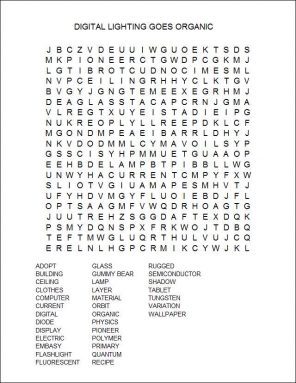Digital lighting goes organic
Research reveals a bright future for a new lighting technology
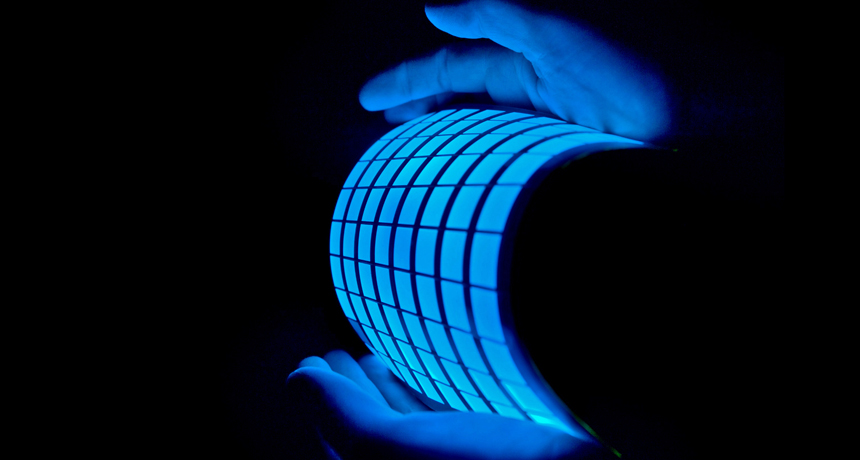
A flexible, lightweight panel made by GE provides diffuse light. The panel is made of organic light-emitting diodes, or OLEDs. This kind of lighting could be more efficient and versatile than old-style light bulbs.
Courtesy GE Lighting
Flick on a light at home and chances are a glass bulb or tube will start to glow. The two most common types of electric lights — incandescent and fluorescent — have worked pretty well for a long time. Make that too long: Both types are so last century.
Incandescent bulbs waste most of their energy. Regular and compact fluorescent tubes are more efficient. However, they contain toxic mercury. Now lighting engineers want us to imagine electric lighting beyond the bulb.
Picture sheets of electric lights that can bend or twist. Your bedroom could have glowing sculptures instead of lamps. A living room window might be transparent by day, then light up at night. The whole kitchen ceiling might glow. And whole walls could be covered with programmable lighting. A few taps on a control panel might change its brightness, color or pattern.
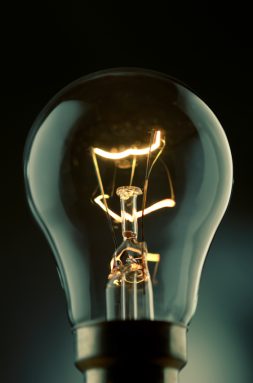
It’s all possible with organic light-emitting diodes, or OLEDs. They are a new type of digital — or solid-state — lighting. Made from solid materials, they don’t require the vacuum now found in an incandescent bulb or the gas that’s encased within fluorescent tubes.
OLED technology doesn’t just promise new designs. It points to better efficiency, fewer environmental risks and longer-lasting products too.
Welcome to lighting in the digital age: The future is going to be bright.
Of sandwiches and coins
Right now, most indoor lighting depends on glass bulbs or tubes. A fluorescent lamp glows when electricity flows through a gas-filled tube. In old-style incandescent bulbs, electricity heats up a tungsten thread until it glows. These bulbs produce more heat than light. In fact, the filament can get much hotter than molten lava.
Digital or solid-state lighting is different. It doesn’t use electricity to make heat that produces light. Instead, it sends electricity through solid materials called semiconductors. Those materials can release energy directly as light through a process called electroluminescence (Ee-LEK-troh-LOOM-in-ESS-ents).
One form of digital lighting is already popular: light-emitting diodes, better known as LEDs. They light most flat-screen TVs and computer monitors. Traffic lights, car headlights and taillights, flashlights and even some flashy sneakers also use LEDs. While they’re used like bulbs, LEDs are actually bits of flat wafers. One 10 × 10 centimeter (4 × 4 inch) wafer can yield thousands of chips as small as a grain of sand.
Both LEDs and OLEDs rely on electroluminescence. However, organic LEDs, or OLEDs, offer more design flexibility. Differences in the manufacturing process let OLEDs be made in bigger sheets on flexible surfaces. And while LEDs often function as bright point sources of light, OLEDs can provide softer, more diffuse light.
To understand an OLED, start by thinking of it as a sandwich.
Electrical conductors, called electrodes, make up the two outer layers of an OLED. One layer has extra electrons (the subatomic particles whose movement creates an electric current). The other layer has bonus “holes.” The holes are spaces where electrons can go. And at least one of the layers is transparent. That way, when an OLED lights up, people can see the illumination.
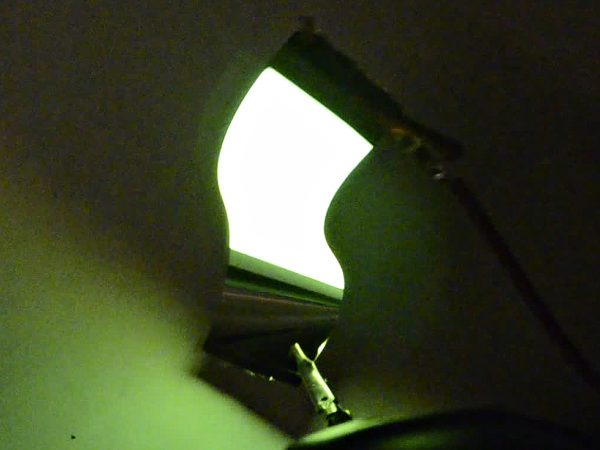
Wedged between the outer layers is a semiconductor. It carries electric current under some conditions but not others. In OLEDs, the semiconductor contains carbon. Carbon is found in all living things. Thus, scientists often say carbon-based materials are organic, even if they’re not alive. In OLEDs, the organic materials are usually polymers. (These are chemicals that have many repeating groups of atoms in long chains.)
Applying a power source to the OLED’s outer layers will make an electric current flow through the device. As that happens, the extra electrons from one outer layer enter the OLED’s semiconductor core.
When an electron finds a hole in the semiconductor, it drops into it. There it settles inside the organic layer, explains Yiting Zhu. She’s a researcher at the Lighting Research Center at Rensselaer Polytechnic Institute (RPI) in Troy, N.Y.
At this happens, the other outer layer pulls electrons out. That action puts new holes in the semiconductor. “One electrode injects electrons, and the other injects holes,” explains Valy Vardeny. He’s a physicist at the University of Utah in Salt Lake City.
Free electrons have a higher energy level than do the electrons that orbit an atom’s nucleus. Think of how you’re all revved up when you’re playing sports. Electrons enter the semiconductor layer in that higher energy state.
When an electron settles into the semiconductor layer, it falls into a lower-energy hole. Think of how you might sink into a comfy armchair to rest after a big game. But now the extra energy has to go somewhere. The OLED releases that extra energy in the form of light. This is electroluminescence.
That’s not the end of the story. As long as the electric current flows, the outer layers keep injecting electrons and holes into the semiconductor. So the light stays on.
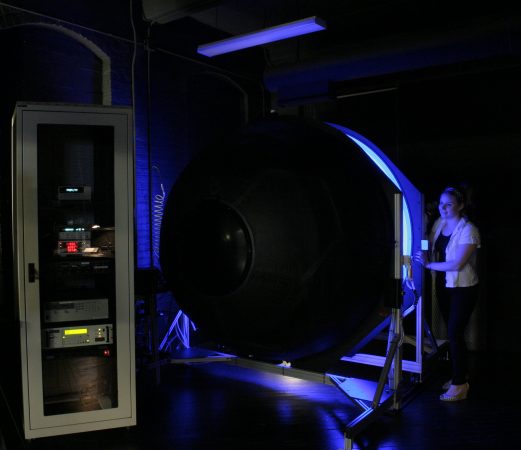
Lighting with changeable colors
An OLED usually emits red, blue or green light. These are the three primary colors. Which color depends on what else the semiconductor layer contains besides carbon.
OLEDs in some high-end TVs, cell phones and tablets include layers that can produce all three primary colors.
The layered effect makes an OLED a bit like a hero sandwich. Switching on and off these red, blue and green layers, either singly or in combination, allows an individual OLED to produce a full range of colors. To glow white, OLED lights usually combine the light emissions from all three layers. For black, all layers would turn off.
Changing a semiconductor’s chemical make-up allows you to go beyond just color. It also can change a color’s hue and other characteristics. For instance, instead of just green, an OLED can be tuned to produce a vivid emerald green or a pale lime green. Still, whatever recipe is used, each semiconductor layer has been able to emit only one color at a time, notes Vardeny.
That’s because the semiconductor normally has just one of two electronic states. It’s like a coin with two sides. When it lands, it’s either heads or tails. In the semiconductor’s case, it can be one color or another. Never both.
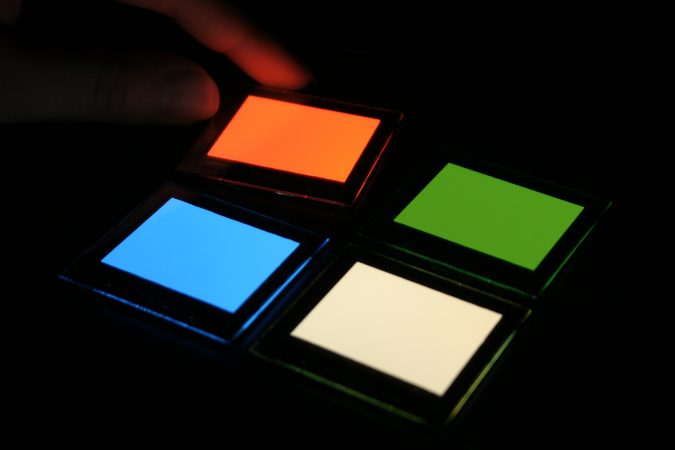
Until now.
Recently, Vardeny and his colleagues coaxed a single semiconductor layer into emitting two different colors of light— at the same time. They reported their discovery in the September 2013 issue of Scientific Reports.
“Finding a polymer that emits two colors is like finding a human being with two heads,” says Vardeny. “It’s that surprising.”
Quantum physics deals with what happens at the atomic or subatomic level. The new semiconductor contains a tiny bit of platinum. And at the level of quantum physics, that precious metal acts like a mixer. It essentially lets the semiconductor exhibit both electronic states — equivalent to the coin’s heads and tails — at once. This allows the semiconductor to emit two different colors at the same time.
Vardeny’s team made a semiconductor where one state emits violet light and the other emits yellow. Violet is really red plus blue light. Yellow is red plus green light. Those two hues include all three primary colors of light, so their combined light looks white.
The process offers a way to make white OLEDs with a single semiconductor. Using one layer instead of two or three could make OLED lighting less costly.
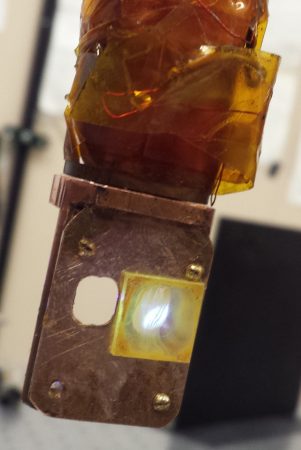
Why organic?
Fluorescent lights can be unpleasant. Not OLEDs. “The lighting quality is better,” says Lu Li. He’s a materials engineer at the University of California, Los Angeles (UCLA). OLEDs have none of the flicker or glare associated with fluorescents, he notes. OLED light also is soft, or more diffused.
And OLEDs emit light in all directions. This quality makes OLEDs ideal for display screens as well as lighting, says Bernard Kippelen. He heads a center in Atlanta at the Georgia Institute of Technology where experts research OLEDs and other organic electronics. It’s called the Center for Organic Photonics and Electronics (COPE).
Look at a conventional TV or computer screen from the side. In many cases the image will appear distorted. But an OLED image will look clear, no matter what your viewing angle is. Backlights on conventional screens also make shadowy scenes seem too dark. OLED screens produce better contrast because each color layer itself lights up. And unlit black areas are all black from the absence of light — not backlit with dark gray.
Making regular LEDs requires very hot temperatures. Making OLEDs doesn’t. “They can be processed at nearly room temperature,” says Kippelen. As a result, OLEDs can be put on almost anything, from a sheet of glass to very thin plastic. Inkjet printers could even do the job.
Such features open up lots of design possibilities. “You can bend [OLEDs] into any shape you want,” says Nadarajah Narendran. He’s the research director at RPI’s Lighting Research Center. Imagine having a roll-up TV or a cell phone that wraps around your wrist. A ceiling could have curved lighting. “Even your drapes can become OLEDs,” he says.
These ideas are not just dreams. Li and other UCLA researchers have already made a flexible OLED. They described it in the September 2013 Nature Photonics. (Photonics deals with the properties and transmission of tiny particles of light energy.)
Their new OLED material is bendable and stretchable. Plus, you can see through it.
“It almost looks like a gummy bear, but its stretchability is better,” notes Li. Think about the elastic hair bands that hold ponytails in place. The new OLED material is about as stretchable, he says.
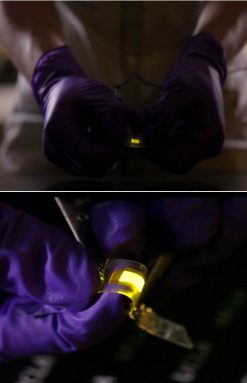
OLEDs also are environmentally friendly. Regular LEDs can contain arsenic. And fluorescent lights usually have mercury in them. Both are toxic. Disposing of them requires special handling. That’s not true for OLEDs. “You throw them away, and in a few days they are part of Mother Earth,” says the University of Utah’s Vardeny.
And, Zhu adds, “Energy savings are going to be huge.” Within five or six years, OLEDs could provide twice as much light per unit of power as fluorescent bulbs. Even more dramatically, the output per watt could be 10 or 20 times as high as that of traditional bulbs.
Moving ahead
The way OLEDs emit light is only part of the story. The way people perceive and experience light matters too. Thus, Narendran’s group at RPI studies what types of lighting would and wouldn’t work in the real world. Just because something is possible with OLEDs doesn’t mean it’s a good idea, says Narendran.
“If every inch of your wall and ceiling is glowing, it will drive you nuts,” he predicts. Most people prefer some variation and shadows. These qualities add visual interest. They also make it easier to see the texture of furniture or fabrics.
Efficiency and durability matter too. To increase both, RPI’s Zhu tests OLED technologies. Some of the goals include making OLEDs cheaper to manufacture and to use. They also need to be more rugged and last longer. Fortunately, experts are making progress on all these fronts, she says.
Meanwhile, Kippelen’s team has found a way to make the outer electrode layers more stable. Over time, the common metals in many electrodes react with oxygen in the presence of moisture. In other words, they rust. New organic materials can reduce that problem. The researchers described the materials two years ago in the journal Science.
These and other improvements will help OLEDs compete better with existing technologies. OLED displays are already in some smartphones and tablets. The prices for larger displays remain high. For example, today a top-of-the-line 55-inch OLED TV may cost $9,000.
Lighting rooms with OLEDs is even newer. A few offices already incorporate the pioneering technology. Among them: the U.S. embassy in Helsinki, Finland.

For now, LED technology is more advanced than that for OLEDs. Nor will OLED lights ever entirely replace LEDs. Narendran says LEDs will always work better for smaller light sources that direct light to a certain spot. “OLEDs are good for larger areas and more diffuse light within the space,” he says.
For the typical home, office or school, OLEDs still aren’t big enough, affordable enough or durable enough. Getting there will take several more years of work by researchers. When OLED lighting does enter wider use, it will offer lots of possibilities beyond the traditional light bulb.
“OLEDs have the potential to change the whole environment,” Narendran predicts. For example, OLED lighting needn’t be limited to fixtures. It could become part of the building. It could be part of the furniture. It might even become part of our clothes.
The uses for OLEDs are only limited by our imagination. What are your ideas for a brighter future?
Power Words
diffuse Spread out.
diode An electronic part that works like a one-way valve for electric current.
electric current A flow of charge, called electricity, along a given path. This usually results from the movement of negatively charged particles, called electrons.
electrode An electric conductor through which current leaves or enters an object, substance or region.
electroluminescence The process by which the passage of an electric current through some semiconductors will discharge some energy as visible light.
engineer A person who uses science to solve problems. As a verb, to engineer means to design a device, material or process that will solve some problem or unmet need.
fluorescent Capable of absorbing and reemitting light. That reemitted light is known as fluorescence.
hue The attribute of a color by which it may be distinguished.
incandescent light The old-style lighting technology that relied on a glass bulb. Electricity passing through the bulb heated a thread-like tungsten filament, making it glow white hot. This created the light used to illuminate everything from a tiny flashlight to whole rooms. Many governments have moved to ban these bulbs because they waste so much of their energy as heat.
LED (light-emitting diode) A semiconductor device that produces light.
OLED Abbreviation for organic light-emitting diode, a type of digital lighting technology that uses a semiconductor to produce illumination.
organic In chemistry and materials science, a term that means something contains carbon. (Not to be confused with the more general defintion for organic, which refers to living or once-living things. In food, organic also can mean “natural.”)
photonics Technology and research on the properties and transmission of light particles, called photons.
platinum A naturally occurring silver-white metallic element that remains stable (does not corrode) in air. It is used in jewelry, electronics, chemical processing and some dental crowns.
polymer A chain-like molecule made up of many identical links, each consisting of several atoms. Most plastics and many other organic compounds are polymers.
primary colors A group of colors from which all other colors can be obtained by mixing. In light, the primary colors are red, green and blue.
quantum physics The scientific study of phenomena that occur at the atomic and subatomic scale.
semiconductor A material whose ability to carry an electric current lies between that of a conductor and an insulator.
smartphone A cellular (or mobile) phone that can perform a host of functions, including searching for information on the Internet.
vacuum Space with little or no matter in it. Laboratories or manufacturing plants may use vacuum equipment to pump out air. In an incandescent bulb, the filament is contained in a vacuum.
